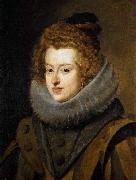Wholesale Oil Painting No Minimum |
|||||||||||
|
|
|||||||||||

|
|||||||||||
|
|
|
||||||||
Diego VelazquezSpanish Baroque Era Painter, 1599-1660 Spanish painter. He was one of the most important European artists of the 17th century, spending his career from 1623 in the service of Philip IV of Spain. His early canvases comprised bodegones and religious paintings, but as a court artist he was largely occupied in executing portraits, while also producing some historical, mythological and further religious works. His painting was deeply affected by the work of Rubens and by Venetian artists, especially Titian, as well as by the experience of two trips (1629-31 and 1649-51) to Italy. Under these joint influences he developed a uniquely personal style characterized by very loose, expressive brushwork. Although he had no immediate followers, he was greatly admired by such later painters as Goya and Manet |
||||||||
|
|
||||||||
Infanta
Infanta Painting ID:: 62307 |
1630 Oil on canvas, 60 x 46 cm Museo del Prado, Madrid When the Infanta Do?a Mar?a, daughter of Philip III and Queen Margarita, set out for Vienna in December 1629 to meet the husband who had been chosen for her long before, the king of Hungary, later Emperor Ferdinand III, her journey included a stay of several months in Naples in 1630. Vel?zquez made haste to Naples to portray his sovereign's sister', who was famous for her beauty. He worked with the utmost care to emphasize the enamel-like smoothness of her fine features. Every detail, for instance the typically protuberant Habsburg lower lip, shows a striking similarity to the living model. The delicate carmine of her lips, the beautiful Titian shade of her hair, depicted in relaxed brushstrokes with dark brown shadows and bright yellow highlights, all display the artistic skill now at the command of Vel?zquez in his harmonious combination of state splendour with the individuality of his sitter. The carefully modelled face in this head-and-shoulders portrait was to serve as the basis for several full-length portraits of the Infanta, workshop copies that may have been intended as gifts to royal residences abroad 1630 Oil on canvas, 60 x 46 cm Museo del Prado, Madrid When the Infanta Do?a Mar?a, daughter of Philip III and Queen Margarita, set out for Vienna in December 1629 to meet the husband who had been chosen for her long before, the king of Hungary, later Emperor Ferdinand III, her journey included a stay of several months in Naples in 1630. Vel?zquez made haste to Naples to portray his sovereign's sister', who was famous for her beauty. He worked with the utmost care to emphasize the enamel-like smoothness of her fine features. Every detail, for instance the typically protuberant Habsburg lower lip, shows a striking similarity to the living model. The delicate carmine of her lips, the beautiful Titian shade of her hair, depicted in relaxed brushstrokes with dark brown shadows and bright yellow highlights, all display the artistic skill now at the command of Vel?zquez in his harmonious combination of state splendour with the individuality of his sitter. The carefully modelled face in this head-and-shoulders portrait was to serve as the basis for several full-length portraits of the Infanta, workshop copies that may have been intended as gifts to royal residences abroad |
|||||||
|
CONTACT US |

